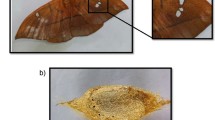Abstract
This article discusses the prospects for a completely new species for use as a non-mulberry silkworm and supposes that the resulting silk from this silkworm has various biomedical applications as a natural biomaterial. Two giant peacock moths with a light trap were caught: a female moth on the first night (28th May), then the next night (29th May) female moth was used, and successfully it was caught a male moth, in the mountain village of Bash-Shabalyd in the region of Sheki. These two moths were carefully transferred to a carton covered with gauze and transferred to the laboratory. The percentage of the cocoon shell from the mass of the entire cocoon was calculated. The authors described the biological characteristics of Saturnia pyri (S. pyri), the period of growth and development of the caterpillar from hatching to pupation in vitro. It was concluded that the silk-bearing capacity of S. pyri cocoons is not inferior to that of the oak silkworm (Antheraea pernyi) and can be widely used in sericulture to obtain biomedical smart materials, which are successfully obtained from other non-mulberry silkworms.











Similar content being viewed by others
References
Altman GH, Diaz F, Jakuba C, Calabro T, Horan RL, Chen J, Lu H, Richmond J, Kaplan DL (2003) Silk-based biomaterials. Biomaterials 24(4):401–416
Biram Saheb NM, Singh T, Kalappa HK, Saratchandra B (2005) Mating behaviour in mulberry silkworm, Bombyx mori (L.). Intern J of Industr Entom 10(2):87-94
Brehm G (2017) A new LED lamp for the collection of nocturnal Lepidoptera and a spectral comparison of light-trapping lamps. Nota Lepi 40(1):87–108. https://doi.org/10.3897/nl.40.11887
Bura VL, Fleming AJ, Yack JE (2009) What’s the buzz? Ultrasonic and sonic warning signals in caterpillars of the great peacock moth (Saturnia pyri). Naturwissenschaften 96:713–718. https://doi.org/10.1007/s00114-009-0527-8
de S Bittencourt-Rodrigues R, Zucoloto F (2009) How feeding on young and old leaves affects the performance of Ascia monuste orseis (Godart) (Lepidoptera, Pieridae). Rev Brasil de Entom 53(1):101–106. https://doi.org/10.1590/S0085-56262009000100023
Forbes WTM (1930) The silkworm of Aristotle. Clas Philol 25(10):22–26
Gogoi D, Choudhury AJ, Chutia J, Pal AR, Khan M, Choudhury M, Pathak P, Das G, Patil DS (2014) Development of advanced antimicrobial and sterilized plasma polypropylene grafted Muga (Antheraea Assama) silk as suture biomaterial. Biopolymers 101(4):355–365. https://doi.org/10.1002/bip.22369
Gritsenko DA, Kenzhebekova RT, Deryabina ND, Galiakparov NN (2019) Development of a "deconstructed" vector based on the genome of grapevine virus A. Plant Biotech Rep 13(2):169–177
Jacobson GG (1908) Instruction for collecting, storing and shipping insects and observing their life. Petersburg Publishing House, St. Petersburg, Imperial St
Kaygusuz I, Sabbah H (2010) Teaching, history, philosophy. Su Publishing House, Istanbul
Knight AL, Stewart W, Basoalto E (2019) Importance of trap liner adhesive selection for male moth catch (Lepidoptera: Tortricidae) with bisexual attractants. J of Appl Entom 143(1–2):95–104. https://doi.org/10.1111/jen.12564
Kumar R, Shukurova ZY (2018) Wild silk moths’ conservation status in India. Proc of the GRI of ANAS 7(1):122–129
Kundu SC, Kundu B, Talukdar S, Bano S, Nayak S, Kundu J, Mandal BB, Bhardwaj N, Botlagunta M, Biraja C, Dash BC (2012) Non-mulberry silk biopolymers. Biopolymers 97(6):455–467. https://doi.org/10.1002/bip.22024
Lee Y-W (1999) Silk reeling and testing manual. Food and Agriculture Organization of the United Nations, Rome
Mammadov ZM, Shamiyev TX (2010) Experience of laboratory cultivation of pear Saturn (Saturnia pyri den et schiff.). Proc of the Azerbaijan Soc of Zoolog 2:337–340
Morgan TH (1907) Experimental zoology. Macmillan & CO., LTD, London
Panagiotakopulu E, Buckland PC, Day PM, Doumas CA, Sarpaki A, Skidmore P (2015) A lepidopterous cocoon from Thera and evidence for silk in the Aegean Bronze Age. Antiquity 71(272):420–429. https://doi.org/10.1017/S0003598X00085021
Pozharskiy AS, Aubakirova KP, Gritsenko DA, Tlevlesov NI, Karimov NZ, Galiakparov NN, Ryabushkina NA (2020) Genotyping and morphometric analysis of Kazakhstani grapevine cultivars versus Asian and European cultivars. Genet Mol Res 19(1):gmr18482
Sahu N, Pal S, Sapru S, Kundu J, Talukdar S, Singh NI, Yao J, Kundu SC (2016) Non-mulberry and mulberry silk protein sericins as potential media supplement for animal cell culture. Hindawi Publ Corp BioMed Res 1:7461041. https://doi.org/10.1155/2016/7461041
Scoble MJ (1992) The Lepidoptera: Form, function, and diversity. OUP Oxford, Oxford
Shukurlu YH, Aliyev KhA, Shukurova ZY (2019) NT O 10: Prospects of breeding wild species of silkworm of the Giant Peacock Moth (lat. Saturnia pyri, Denis & Schiffermüller, 1775) as one of the branches of sericulture in Azerbaijan. Tsukuba, Japan
Symonds MRE, Johnson TL, Elgar MA (2012) Pheromone production, male abundance, body size, and the evolution of elaborate antennae in moths. Ecol and Evolut 2(1):227-246. https://doi.org/10.1002/ece3.81
Wenwen H, Shengjie L, Chunmei L, Fiorenzo GO, David LK (2018) Silkworm silk-based materials and devices generated using bio-nanotechnology. Chem Soc Rev 47(17):6486–6504. https://doi.org/10.1039/c8cs00187a
Zhu Q, Wu N, Brozek J, Dai W (2019) Antennal morphology and sexual dimorphism of Antennal Sensilla in Callitettix versicolor (Fabricius) (Hemiptera: Cercopidae). Insects 10(2):56. https://doi.org/10.3390/insects10020056
Author information
Authors and Affiliations
Corresponding author
Ethics declarations
Conflict of interest
The authors declare that they have no confict of interest.
Additional information
Publisher's Note
Springer Nature remains neutral with regard to jurisdictional claims in published maps and institutional affiliations.
Rights and permissions
Springer Nature or its licensor holds exclusive rights to this article under a publishing agreement with the author(s) or other rightsholder(s); author self-archiving of the accepted manuscript version of this article is solely governed by the terms of such publishing agreement and applicable law.
About this article
Cite this article
Shukurova, Z.Y., Shukurlu, Y.H. Non-mulberry silkworm Saturnia Pyri (Denis & Schiffermüller, 1775) and a new perspective source of biomaterials. Int J Trop Insect Sci 42, 3481–3488 (2022). https://doi.org/10.1007/s42690-022-00878-4
Received:
Accepted:
Published:
Issue Date:
DOI: https://doi.org/10.1007/s42690-022-00878-4




